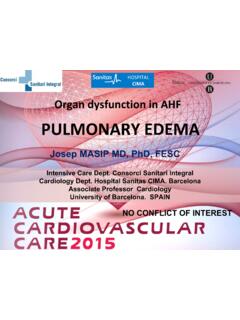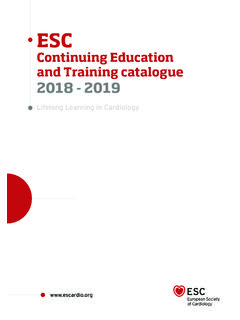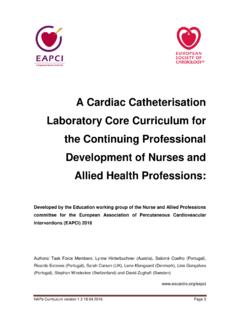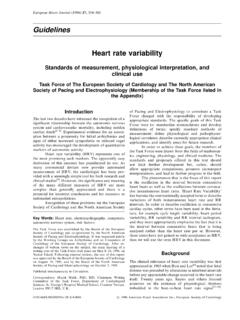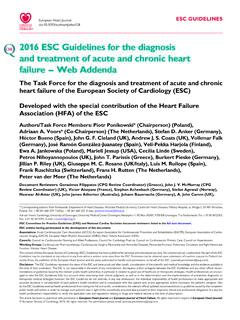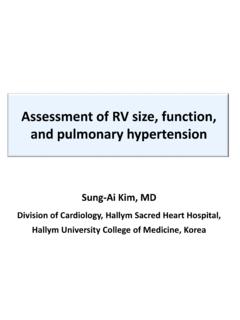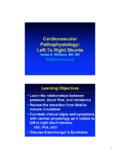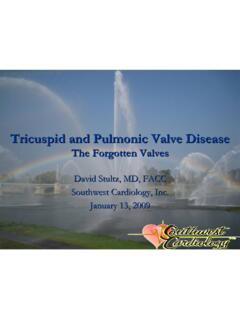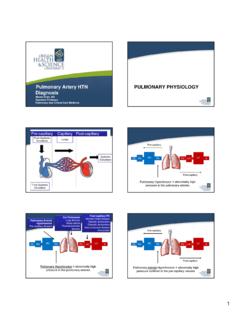Transcription of 2015 ESC/ERS Guidelines for the diagnosis and treatment of ...
1 ESC/ERS GUIDELINES2015 ESC/ERS Guidelines for the diagnosis andtreatment of pulmonary hypertension webaddendaThe Joint Task Force for the diagnosis and treatment of PulmonaryHypertension of the European Society of Cardiology (ESC) and of theEuropean Respiratory Society (ERS)Endorsed by: Association for European Paediatric and CongenitalCardiology (AEPC), International Society for Heart and LungTransplantation (ISHLT)Authors/Task Force Members: Nazzareno Galie`*(ESC Chairperson) (Italy),Marc Humbert*a(ERS Chairperson) (France), Jean-Luc Vachieryc(Belgium),Simon Gibbs (UK), Irene Lang (Austria), Adam Torbicki (Poland), Ge rald Simonneaua(France), Andrew Peacocka(UK), Anton Vonk Noordegraafa(The Netherlands),Maurice Beghettib(Switzerland), Ardeschir Ghofrania(Germany),Published on behalf of the European Society of Cardiology.
2 All rights European Society of Cardiology & European Respiratory article is being published concurrently in theEuropean Heart Journal( ) and theEuropean Respiratory Journal( ). The articlesare identical except for minor stylistic and spelling differences in keeping with each journal s style. Either citation can be used when citing this article.*Corresponding authors: Nazzareno Galie`, Department of Experimental, Diagnostic and Specialty Medicine DIMES, University of Bologna, Via Massarenti 9, 40138 Bologna, Italy,Tel:+39 051 349 858, Fax:+39 051 344 859, Humbert, Service de Pneumologie, Ho pital Bice tre, Universite Paris-Sud, Assistance Publique Ho pitaux de Paris, 78 rue du Ge ne ral Leclerc, 94270 Le Kremlin-Bicetre, France,Tel:+33 145217972, Fax:+33 145217971, Committee for Practice Guidelines (CPG) and National Cardiac Societies document reviewers: listed in AppendixaRepresenting the European Respiratory Society;bRepresenting the Association for European Paediatric and Congenital Cardiology;cRepresenting the Inter-national Society for Heart and Lung Transplantation;dRepresenting the European League Against Rheumatism.
3 AndeRepresenting the European Society entities having participated in the development of this document:ESC Associations:Acute Cardiovascular Care Association (ACCA), European Association for Cardiovascular Prevention & Rehabilitation (EACPR), European Association of Car-diovascular Imaging (EACVI), European Association of Percutaneous Cardiovascular Interventions (EAPCI), European Heart Rhythm Association (EHRA), Heart Failure Association(HFA).ESC Councils:Council for Cardiology Practice (CCP), Council on Cardiovascular Nursing and Allied Professions (CCNAP), Council on Cardiovascular Primary Care (CCPC).ESC Working Groups:Cardiovascular Pharmacotherapy, Cardiovascular Surgery, Grown-up Congenital Heart Disease, pulmonary Circulation and Right Ventricular Function,Valvular Heart content of these European Society of Cardiology (ESC) and European Respiratory Society (ERS) Guidelines has been published for personal and educational use only.
4 No com-mercial use is authorized. No part of the ESC/ERS Guidelines may be translated or reproduced in any form without written permission from the ESC and/orERS. Permission can beobtained upon submission of a written request to Oxford University Press, the publisher of the European Heart Journal or from the European Respiratory Journal and the party author-ized to handle such permissions on behalf of the ESC and :The ESC/ERS Guidelines represent the views of the ESC and ERS and were produced after careful consideration of the scientific and medical knowledge andthe evidenceavailable at the time of their ESC and ERS are not responsible in the event of any contradiction, discrepancy and/or ambiguity between the ESC/ERS Guidelines and any other official recommendations orguidelines issued by the relevant public health authorities, in particular in relation to good use of healthcare or therapeutic strategies.
5 Health professionals are encouraged to take theESC/ERS Guidelines fully into account when exercising their clinical judgment, as well as in the determination and the implementation of preventive, diagnostic or therapeutic medicalstrategies; however, the ESC/ERS Guidelines do not override, in any way whatsoever, the individual responsibility of health professionals to make appropriate and accurate decisions inconsideration of each patient s health condition and in consultation with that patient and, where appropriate and/or necessary, the patient s caregiver. Nor do the ESC/ERS Guidelinesexempt health professionals from taking into full and careful consideration the relevant official updated recommendations or Guidelines issued by the competent public health author-ities, in order to manage each patient s case in light of the scientifically accepted data pursuant to their respective ethical and professional obligations.
6 It is also the health professional sresponsibility to verify the applicable rules and regulations relating to drugs and medical devices at the time of Heart Angel Gomez Sanchez (Spain), Georg Hansmannb(Germany),Walter Klepetkoc(Austria), Patrizio Lancellotti (Belgium), Marco Matuccid(Italy),Theresa McDonagh (UK), Luc A. Pierard (Belgium), Pedro T. Trindade (Switzerland),Maurizio Zompatorie(Italy), and Marius Hoepera(Germany)Document Reviewers: Victor Aboyans (CPG Review Coordinator) (France), Antonio Vaz Carneiro (CPG ReviewCoordinator) (Portugal), Stephan Achenbach (Germany), Stefan Agewall (Norway), Yannick Allanored(France),Riccardo Asteggiano (Italy), Luigi Paolo Badano (Italy), Joan Albert Barbera`a(Spain), He le`ne Bouvaist (France),He ctor Bueno (Spain), Robert A. Byrne (Germany), Scipione Carerj (Italy), Grac a Castro (Portugal), etin Erol(Turkey), Volkmar Falk (Germany), Christian Funck-Brentano (France), Matthias Gorenflob(Germany),John Grantonc(Canada), Bernard Iung (France), David G.
7 Kiely (UK), Paulus Kirchhof (Germany/UK),Barbro Kjellstrom (Sweden), Ulf Landmesser (Switzerland), John Lekakis (Greece), Christos Lionis (Greece),Gregory Y. H. Lip (UK), Stylianos E. Orfanosa(Greece), Myung H. Parkc(USA), Massimo F. Piepoli (Italy),Piotr Ponikowski (Poland), Marie-Pierre Revele(France), David Rigaua(ERS methodologist) (Switzerland),Stephan Rosenkranz (Germany), Heinz Vo ller (Germany), and Jose Luis Zamorano (Spain)The disclosure forms of all experts involved in the development of these Guidelines are available on the ESC pulmonary hypertension pulmonary arterial hypertension Chronic thromboembolicpulmonary hypertension Congenital heart disease Connective tissue disease Heart failure Respiratoryfailure Endothelin receptor antagonists Phosphodiesterase type 5 inhibitors Prostacyclin analogues Lung disease Left heart diseaseList of Web TablesWeb addenda.
8 2 Pathology of pulmonary hypertension ..2 Pathobiology of pulmonary hypertension ..3 pulmonary arterial hypertension screening programme ..5 Quality of life measurements ..8 References ..11 Web addendaPathology of pulmonary hypertensionDifferent pathological features characterise the diverse clinical pul-monary hypertension (PH) ,52 Group 1, pulmonary arterial hypertension (PAH): pathologicalchanges predominantly affect the distal pulmonary arteries(,500mm) with medial hypertrophy, intimal proliferative andfibrotic changes, adventitial thickening with mild to moderateperivascular inflammatory infiltrates and lymphoid neogenesis,complex lesions (plexiform, dilated lesions) and thromboticlesions. pulmonary veins are classically unaffected. Group 1 : includes mainly pulmonary veno-occlusive disease(PVOD) involving septal veins and pre-septal venules with occlu-sive fibrotic lesions, venous muscularization, patchy capillary pro-liferation with pulmonary capillary haemangiomatosis (PCH), pulmonary oedema, occult alveolar haemorrhage, lymphaticdilatation, lymph node enlargement (vascular transformation ofthe sinus) and inflammatory infiltrates.
9 Distal pulmonary arteriesare affected by medial hypertrophy and intimal fibrosis. Group 1 : persistent pulmonary hypertension of the newborn(PPHN) is characterized by changes in vasoreactivity and wallstructure and decreases in pulmonary vascular density with re-duced alveolarisation. Group 2: PH due to left heart disease (LHD) is characterised byenlarged and thickened pulmonary veins, pulmonary capillarydilatation, interstitial oedema, alveolar haemorrhage and lymph-atic vessel and lymph node enlargement. Distal PA may beaffected by medial hypertrophy and intimal fibrosis. Group 3: PH due to lung diseases and/or hypoxaemia is charac-terized by medial hypertrophy, intimal obstructive proliferationof the distal pulmonary artery (PA) and muscularisation of arter-ioles. A variable degree of destruction of the vascular bed in em-physematous or fibrotic areas may also be present.
10 Group 4: PH due to chronic PA obstruction: chronic thrombo-embolic pulmonary hypertension (CTEPH) lesions include or-ganized thrombi tightly attached to the medial layer in theelastic PA, replacing the normal intima. These may occludethe lumen or form different grades of stenosis, webs pulmonary microvascular disease can develop inthe non-occluded and occluded areas that has similarities withPAH (with the exception of uncommon plexiform lesions inCTEPH) and patchy post-capillary remodelling related tobronchial-to- pulmonary venous ,55 Collateral vesselsfrom the systemic circulation (from bronchial, costal, ESC/ERS GuidelinesPage 2 of 13diaphragmatic and coronary arteries) can grow to reperfuseareas distal to complete obstructions. Group 5: PH with unclear and/or multifactorial mechanismsincludes heterogeneous conditions with different of pulmonary hypertensionDifferent pathobiological features56 58characterise the diverseclinical PH groups.
